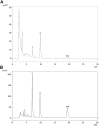Bioassay-guided isolation of leishmanicidal cucurbitacins from Momordica charantia
- PMID: 39055497
- PMCID: PMC11269121
- DOI: 10.3389/fphar.2024.1390715
Bioassay-guided isolation of leishmanicidal cucurbitacins from Momordica charantia
Abstract
Introduction: Leishmaniasis, a neglected tropical parasitic disease, is regarded as a major public health problem worldwide. The first-line drugs for leishmaniasis suffer from limitations related to toxicity and the development of resistance in certain parasitic strains. Therefore, the discovery of alternative treatments for leishmaniasis is imperative, and natural products represent a valuable source of potential therapeutic agents.
Methods: The present study aimed at finding new potential antileishmanial agents from the aerial parts of the medicinal plant Momordica charantia. This study was based on bioassay-guided fractionation of the M. charantia extract against promastigotes and amastigotes of Leishmania (Leishmania) amazonensis. The cytotoxicity of the extract, fractions, and isolated compounds were evaluated against peritoneal murine macrophages by employing the MTT assay for assessing cell metabolic activity.
Results: Antileishmanial assay-guided fractionation of the M. charantia extract led to the bioactive cucurbitacin-enriched fraction and the isolation of four bioactive cucurbitacin-type triterpenoids, which exhibited significant antileishmanial activity, with IC50 values between 2.11 and 3.25 μg.mL-1 against promastigote and amastigote forms, low toxicity and selectivity indexes ranging from 8.5 to 17.2.
Conclusion: Our findings demonstrate that the fractions and cucurbitacin-type triterpenoids obtained from the aerial parts of M. charantia are promising natural leishmanicidal candidates.
Keywords: Cucurbitaceae; Leishmania amazonensis; Momordica charantia; cucurbitacin; leishmanicidal activity; neglected tropical disease.
Copyright © 2024 Marques, Yoshida, Torres-Santos, Garcez and Garcez.
Conflict of interest statement
The authors declare that the research was conducted in the absence of any commercial or financial relationships that could be construed as a potential conflict of interest.
Figures


References
-
- Cargnin S. T., Vieira P. deB., Cibulski S., Cassel E., Vargas R. M. F., Montanha J., et al. (2013). Anti-Trichomonas vaginalis activity of Hypericum polyanthemum extract obtained by supercritical fluid extraction and isolated compounds. Parasitol. Int. 62 (2), 112–117. 10.1016/j.parint.2012.10.006 - DOI - PubMed
LinkOut - more resources
Full Text Sources

